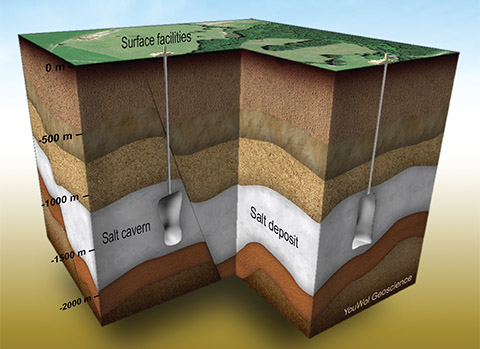Case study: Nothern Europe
Context
- Client: Some data used are collected from existing scientific publications on the Epe repository site.
- Location: Germany, Europe
- Main goal: Man-made caverns to store CO2 and other gas. Model stability and related surface subsidence.
- Geology: Zechstein salt
- Tectonic: Permian European Basin

Methodology
- Data analysis and interpretation
- 3D model of exisiting or planned caverns
- 3D present-day stress models around interacting caverns (ARCH)
- Subsidence modeling based on existing and/or planned caverns (ARCH)

Other applications using similar methodology
This workflow for modeling man-made salt caverns can also be applied to:
- Mining
- Tunneling
- Nuclear waste disposal
Main outcomes
Cavern network data
The main data on salt cavern are:
-
• Location and depth of salt cavern network at repository site
• Shape of each salt cavern measured from sonar survey
• Subsidence caused by salt cavern network over time and measured withe GPS stations and/or satellite data (InSAR)
Cavern shape reconstruction
The main data on salt cavern are:
-
(a) Example of cavern shape data obtained by sonar survey
(b) Reconstructed cavern shape from sonar survey data;
(c) Meshed cavern with triangular elements suitable for 3D geomechanical simulations (ARCH)
Cavern mechanical interaction
-
• 3D stress field is computed (Arch) around two mechanically interacting salt caverns.
• The caverns can be modeled as empty or pressurized cavities.
• Rock mechanical properties are set in Arch as well as the 3D far field stresses (magnitudes and orientations).
Launch YouWol App
Subsidence caused by cavern network
-
Measured (2006) and geomechanically modeled (Arch) subsidence caused by salt cavern network.
The observed subsidence has been taken from Sroka et al. (2018) on the Epe salt repository site (Germany).
Launch YouWol App